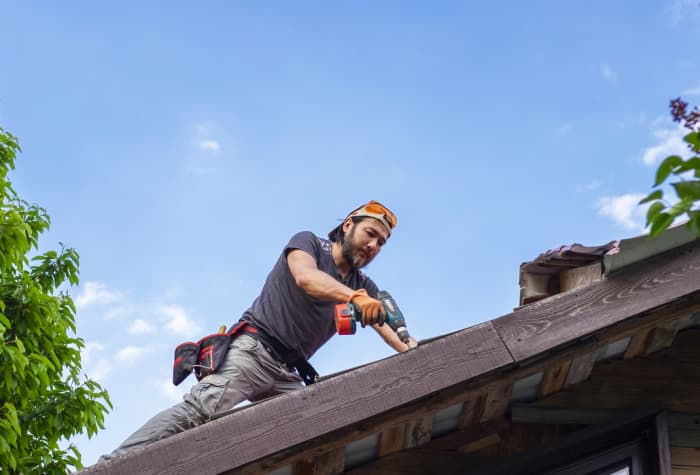The U.S. housing sector is back in full swing and builders are best positioned to ride the wave, Fannie Mae’s
FNMA,
The housing market went into a recession at the end of 2022, after mortgage rates surged from 4% to 7%, making homeownership more expensive, and depressing home sales. Since then, housing has mostly rebounded, but with the housing market seriously short of homes for sale as homeowners hold out on selling, the sector is still facing a fundamental supply-and-demand problem.
The key players poised to reap the benefits of — and permanently fix — this imbalance are home builders, according to two economists at mortgage-financing giant Fannie Mae. The government-owned enterprise purchases mortgage loans from lenders and either holds them on their books, or packages them into mortgage-backed securities — and sells them to the broader market.
“If they get to that level, that will help absorb current demand pretty well,” Doug Duncan, chief economist at Fannie Mae, told MarketWatch. And now for the bad news. “The question is catching up, and we think that will take two or three years,” he added.
“So it looks to us like a pretty good environment for builders for some time,” Duncan said.
Builders have ramped up new construction on homes. In June, builders were on track to complete construction of 1.47 million if they continue at the same pace for the rest of the year.
A decade of underbuilding
A decade of underbuilding is one reason why the U.S. is facing such a shortfall in housing supply, Duncan explained.
According to Realtor.com, the U.S. is short of 6.5 million single-family homes. Realtor.com looked at household formation between 2012 and 2022, housing starts, and home sales.
(Realtor.com is operated by News Corp subsidiary Move Inc., and MarketWatch is a unit of Dow Jones, also a subsidiary of News Corp.
NWSA,
During the Great Recession from 2007 to 2009, builders sharply pulled back on new-home construction. Housing starts fell from an annual rate of 2.27 million in June 2006 to 478,000 in April 2009 — a fall of nearly 80%, as seen in the chart below which spans from 2006 to 2013.
With rising delinquencies and foreclosures, production continued at that low level for a few more years, and builders adjusted to lower demand by downsizing, Duncan explained.
“At the same time, the millennials were coming of age and they are a bigger population group than the boomers,” Duncan added. Meanwhile, he said, “production had sort of gone on idle.”
In the early 2010s, that demand began to pick up and “it became clear to us that there was going to be a supply problem,” he added. “So the housing market has been behind in supply already for the better part of a decade.”
The pandemic hurt production even further, as builders pulled back in the face of uncertain demand, as well as to stop the spread of the coronavirus.
But their doubts about home-buying demand quickly faded. With the U.S. Federal Reserve lowering interest rates, mortgage rates plummeted and home buying surged. During the same period in July 2021, the 30-year was averaging at 2.8%, according to data from Freddie Mac
FMCC,
The opportunity for builders became even greater post-pandemic, as rates rose.
For many homeowners who jumped at the opportunity to buy during the pandemic, current rates make the idea of selling — and buying — unthinkable.
The pandemic also pushed some of these homeowners to embrace remote work, said Mark Palim, deputy chief economist at Fannie Mae.
“For many homeowners who jumped at the opportunity to buy during the pandemic, current rates make the idea of selling — and buying — unthinkable. ”
“You’ve had a significant change in how people work, and where they work,” he added. “People adjusted their housing situation to reflect that. And they don’t need to adjust it again.”
So the supply of previously-owned houses for sale is at a record lows as people hold on to their homes.
For builders, that helps business: In May, new homes formed 31% of the total number of homes for sale, according to the National Association of Home Builders. Typically, that share is only about 10% to 15%.
Sales of newly built homes in the U.S. fell in June, as demand cooled after a jump the previous month, the Commerce Department reported Wednesday. U.S. new-home sales fell 2.5% to an annual rate of 697,000 in June, from a revised 715,000 in the prior month,
Still, builders are also able to offer incentives to aspiring homeowners to help them buy a home, a tactic that most homeowners may not have at their disposal.
D. R. Horton’s
DHI,
And though “home prices and incentives have begun to stabilize, we expect to continue utilizing a higher level of incentives as compared to last year,” he added.
Murray’s co-COO, Paul Romanowski, said on the same call that the rate buydown in particular has been “one of our most effective incentives.” A rate buydown is when a mortgage lender or home builder offers a lower rate in the first few years of repayment, after which they permanently reset to a higher rate. The seller or a builder pays a sum of money upfront to “buy the rate down” at the start of the payment period.
But both economists said that they believe the lock-in effect of high mortgage rates discouraging homeowners to sell will fade over time, due to circumstances in life. People may need to sell their home and relocate for a new job opportunity, or if they are expanding their family, or downsizing as they approach retirement.
For the time being, however, home buyers should not expect relief to come in the form of lower mortgage rates, the economists said.
“We don’t see rates coming down very far,” Duncan stated. In its July housing forecast, Fannie Mae said it expected the 30-year mortgage to end the fourth quarter of 2023 at 6.6%, and in the fourth quarter of 2024 at 5.9%.







